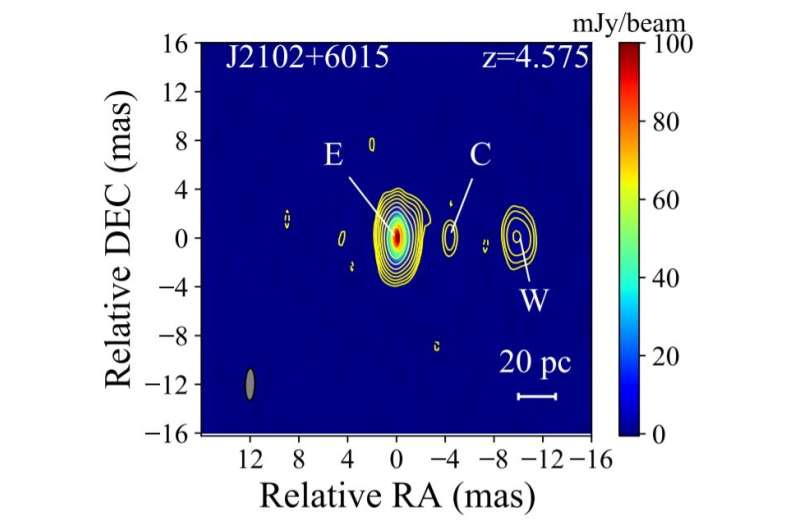August 16, 2021 report
Radio source J2102+6015 investigated in detail

An international team of astronomers has conducted a detailed study of a high-redshift young radio source designated J2102+6015. Results of the research, presented in a paper published August 4 on arXiv pre-print repository, deliver more hints regarding the nature of this source.
At a redshift of 4.57, J2102+6015 is a radio source assumed to be a powerful radio quasar. Previous observations of this source using very long baseline interferometry (VLBI) have shown that it has a compact structure confined at 2.3 GHz. Moreover, at 8.6 GHz, the source was resolved into three components extending along east-west direction and an additional weak component west of the peak emitting region.
The studies of J2102+6015 have also found that it has an inverted radio spectrum peaking at about 1.0 GHz, which indicates that it may be a gigahertz-peaked spectrum (GPS) source. Its brightest VLBI component has a moderate brightness temperature of approximately 40 billion K, and is thus smaller than expected from a Doppler-boosted jet emission. All these properties seem to suggest J2102+6015 is a non-blazar source.
In order to further investigate this hypothesis and to shed some light on the nature of J2102+6015, a team of astronomers led by Yingkang Zhang of Shanghai Astronomical Observatory decided to analyze multi-epoch dual-frequency VLBI data of this source.
"In this paper, we present a detailed study of the mas-scale radio morphology, spectral index distribution, and component proper motion in this peculiar source, based on an extensive collection of archival and new dual-frequency VLBI data," the researchers explained.
By analyzing the VLBI datasets, Zhang's team found that J2102+6015 has a compact, bright eastern component and a weaker western component, both having flat or inverted spectra. A weak component between the eastern and western features has been also found for the first time. The astronomers assume that this weak component might be the AGN (active galactic nucleus) core or a knot in the eastern jet.
The researchers compared flux densities obtained from VLBI and low-resolution radio observations. The results point out to almost no diffuse emission extended to arcsec scales. The flux density of the source was found to be fairly stable over a period of 24 years.
Furthermore, the study found that the angular separation speed between the eastern and western features of J2102+6015 is some 0.023 mas per year. This result suggests that the radio source has a kinematic age of about 440 years. It was also found that the radio spectrum is peaking at around 6.0 GHz in the source rest frame.
All in all, the astronomers concluded that the results of their research indicate that J2102+6015 is most likely a compact symmetric object (CSO)–radio-emitting AGN typically with a double-lobed radio structure confined to within approximately 3,300 light years.
"Previous studies have classified the source as a GHz-peaked spectrum quasar. Our results indicate that J2102+6015 is most likely a young, compact symmetric object rather than a blazar-type core–jet source," the authors of the paper wrote.
More information: J2102+6015: a young radio source at z = 4.575, arXiv:2108.02142 [astro-ph.HE] arxiv.org/abs/2108.02142
© 2021 Science X Network




















